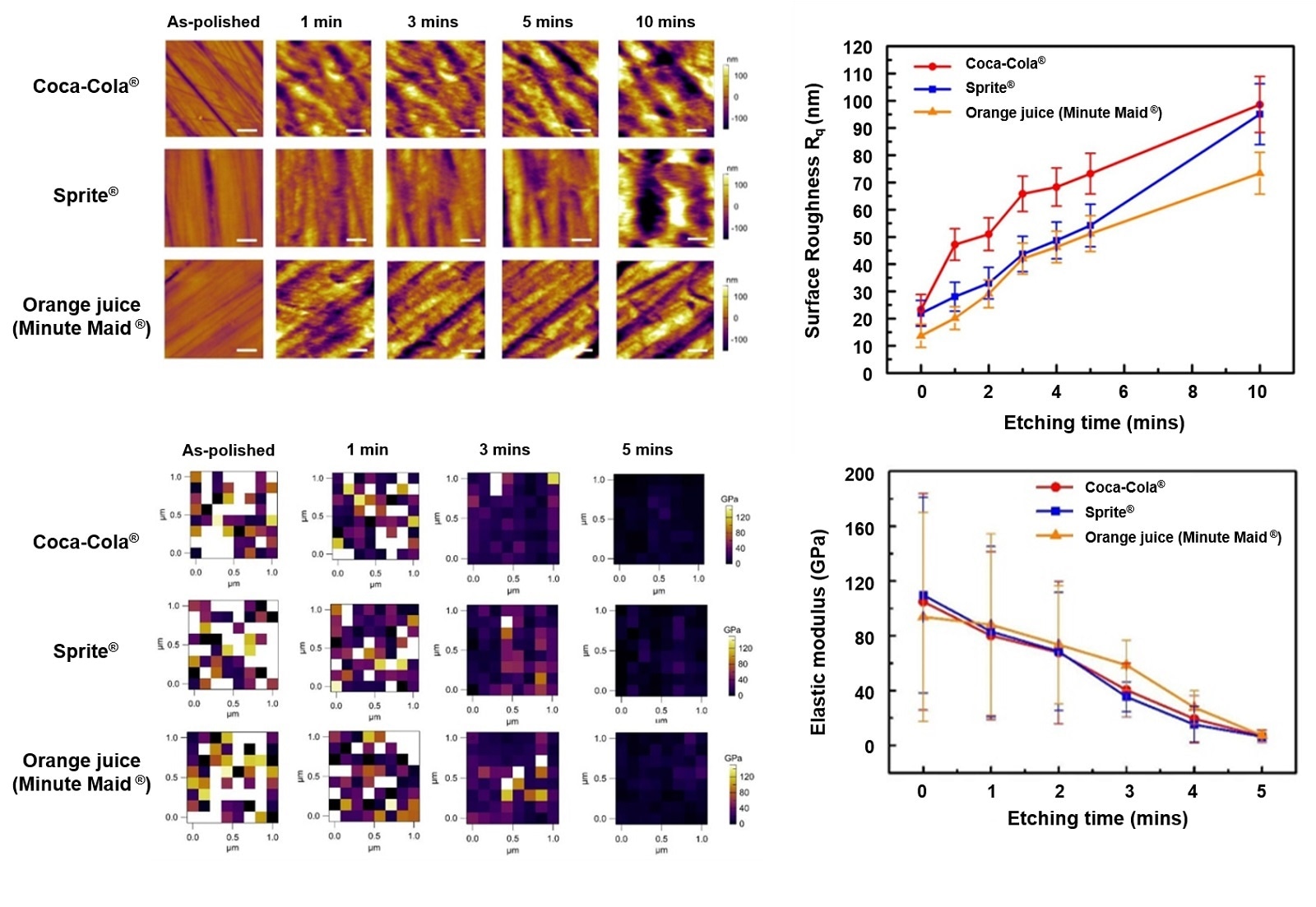Using atomic force microscopy, researchers from The Korea Advanced Institute of Science and Technology (KAIST) have quantitatively assessed the effect of sugary and acidic drinks on human tooth enamel at the nanoscale level.

Changes in surface roughness (top) and modulus of elasticity (bottom) of tooth enamel exposed to popular beverages imaged by atomic force microscopy. Image Credit: Professor Seungbum Hong, The Korea Advanced Institute of Science and Technology.
This innovative method is handy for quantifying morphological and mechanical changes that take place over time due to enamel erosion caused by beverages.
Enamel is essentially the hard-white substance that forms the exterior of a tooth. It is stronger than bone, making it the hardest substance in the human body. Its hard surface is made of 96% mineral—the maximum percentage of any body tissues—rendering it damage-resistant and durable. The enamel serves as a barrier to safeguard the tooth’s soft inner layers, but can become sensitive to degradation by sugars and acids.
The enamel will erode when the tooth enamel is overexposed to excess consumption of sugary and acidic food and drinks. If enamel loss is not treated, it can result in numerous tooth conditions including sensitivity, translucence, fractures, and stains.
Damaged tooth enamel can never be brought back; hence, detailed analyses on how enamel erosion begins and develops, particularly at the initial stages, are of high clinical and scientific relevance to maintain dental health.
A team of researchers, headed by Professor Seungbum Hong from the Department of Materials Science and Engineering at KAIST, has now reported a novel approach of applying atomic force microscopy methods to analyze the nanoscale characterization of this enamel erosion at the early stage. The research was published in the Journal of the Mechanical Behavior of Biomedical Materials (JMBBM) on June 29th, 2020.
Atomic force microscopy is a very-high-resolution type of scanning probe microscopy (SPM), with proven resolution on the order of fractions of a nanometer that is equivalent to one billionth of a meter. Atomic force microscopy creates images by scanning a tiny cantilever across the sample surface, and this can accurately quantify the mechanical and structural properties of the sample, like elastic modulus and surface roughness.
The study’s co-lead authors, Dr Panpan Li and Dr Chungik Oh, selected three popular beverages available on the market—Minute Maid® orange juice, Sprite®, and Coca-Cola®—and immersed the tooth enamel in these drinks over time to assess their effects on human teeth and to track the etching procedure on tooth enamel.
The researchers obtained five healthy human molars from volunteers aged between 20 and 35, who came to the KAIST Clinic. Post extraction, the teeth were maintained in distilled water prior to the experiment. All the drinks were bought and opened just before the immersion experiment, and the researchers used atomic force microscopy to measure the elastic modulus and surface topography map.
The team noted that as the immersion time is increased, the surface roughness of the tooth enamel also increased considerably, whereas the elastic modulus of the enamel surface reduced significantly.
The researchers showed that the surface of the enamel roughened five times more when it was submerged in the drinks for 10 minutes, and they also demonstrated that the elastic modulus of the tooth enamel was lower by five times after it was immersed in the drinks for five minutes.
The scientists also noted preferential etching in the scratched tooth enamel. The study revealed that brushing the teeth too hard or toothpastes with polishing materials that are endorsed to eliminate dental biofilms can cause abrasions on the surface of the enamel, which can be preferential locations for etching.
Our study shows that AFM is a suitable technique to characterize variations in the morphology and mechanical properties of dental erosion quantitatively at the nanoscale level.”
Seungbum Hong, Professor, Department of Materials Science and Engineering, The Korea Advanced Institute of Science and Technology
Source:
Journal reference:
Li, P., et al. (2020) Nanoscale effects of beverages on enamel surface of human teeth: An atomic force microscopy study. Journal of the Mechanical Behavior of Biomedical Materials. doi.org/10.1016/j.jmbbm.2020.103930.